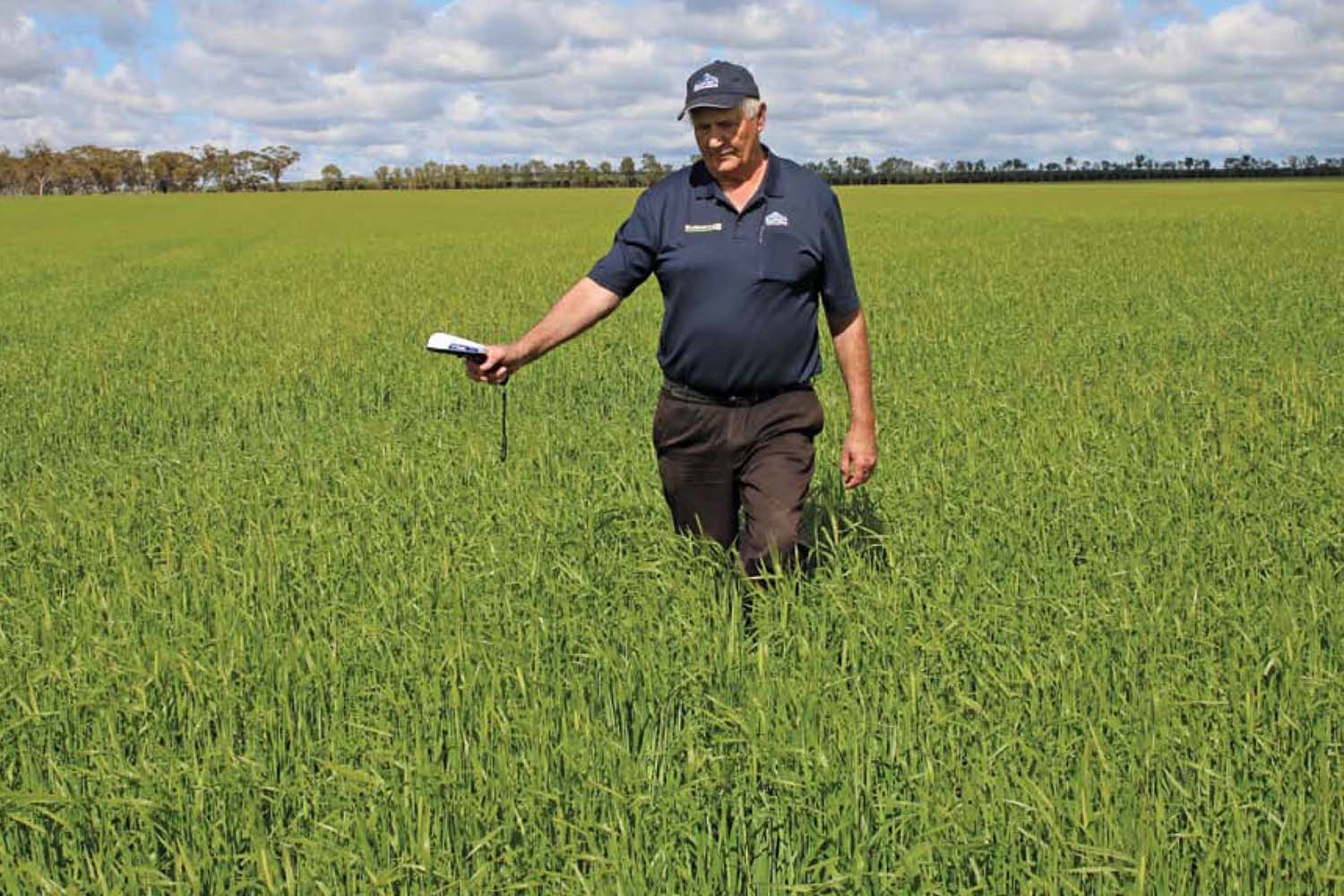Alan Manton started boosting potassium (K) nutrition by adding top-dressed MOP on paddocks he thought needed extra K. Wanting to make K available early to his crops, he then started having K blended in with his compound sowing fertilizer. In more recent years Alan has preferred to use a fully compounded starter fertilizer - Summit Vigour - which has NPK, sulphur and trace elements fully compounded into every granule. Alan is pictured above (centre) with his Summit Area Manager Steve Cooke and Summit Northern Regional Manager, Wayne Foot.
Ten years ago, Alan and Kelly Manton of Yealering were budgeting for 1.6 to 1.8 t/ha wheat crops. Five years ago the plans would have been drawn up based on 2.1 or 2.2 t/ha yields, so with their current 10 year average for wheat now sitting around 2.6t/ha and 3t/ha for barley, it’s clear yields are continuing to improve despite annual rainfall going down.
There is no doubt yield improvements have been largely driven by Alan’s willingness to adopt new technology.
Getting things in balance has been a key driver to productivity, with adjustments to soil pH through a solid liming program and recognising crop nutrition requirements relative to rainfall and yield potential. More phosphorus (P) and also more nitrogen (N) and potassium (K) applied early to hasten crop biomass production has been key.
A focus in more recent years has been on K nutrition. The Manton’s soil types are dominated by lighter country, mostly sand over gravel or sand over loam.
Soil K levels a decade ago were typically 20 to 30ppm. Those levels have progressively built up by applying K down the tube at sowing with Summit’s NPK products Vigour (12% K) or Vigour Boost (16.4% K), and topdressing MOP on a broader scale.Most paddocks now have K levels between 80 and 120ppm.
It’s fair to say for those that know Alan that he’s a thoughtful farmer and directed more by the science than gut feel. Knowledge is guiding the way and Summit Area Manger, Steve Cooke, has been laying down in-season Fuel Gauges on the Manton’s farm for the past 5 years. He started with N enriched strips and Alan said he could easily see his crops would respond to more N, they just needed to determine how much would give the best economic response.

“Last year Steve put down N and N plus K strips and there was a very distinctive K response above the straight N application. That indicated there was a solid interaction between the extra potash and nitrogen that was extremely beneficial to the crop,” Alan said
“Steve’s Fuel Gauges generally go down between four and six weeks after seeding. What’s interesting is that crop growth in the enriched strips never shows up to the eye straight away. It’s not until about 12 weeks after seeding that we start to get a visual response.
“The benefit of Summit putting in the Fuel Gauges is that Steve uses the GreenSeeker® technology to read the differences in biomass in the treated and untreated. That gives us an answer well before we can visually see any difference.
“So, if we’re 15 or 25 units of N short of where optimal productivity would be, we can go and address the problem in-season.
“The best place to put the Fuel Gauge in is on relatively average parts of the paddock so we can say, okay, if we can get a response there, it’s likely to respond across the rest of the paddock.
“Last year’s N plus K strips gave us the confidence to go out and try to replicate the result on a broader scale on different varieties of crops. This year we put in larger paddock scale strips in barley, wheat and oats to see if a decent kick of K above what we would normally apply will yield an economic response.
“Again, Summit tools have been useful to help assess the results. In a small-scale Fuel Gauge trial, the handheld GreenSeeker® works well, but on broader paddock size strip trials you can’t be everywhere with the hand-held device.
“That’s where Summit’s access to the satellite NDVI images (courtesy of DataFarming®) has been handy. Already from the maps we have started to see where we put on the MOP/ urea blend as opposed to our normal practice of straight urea.
“So, I think we’re on the right track. We have to keep everything in balance. We can’t overextend, pour on more urea and not have it 100% utilised because there isn’t enough K available.”
Alan’s paddock trials will be taken through to harvest and should yield some interesting results.
Each paddock trial had a 100m strip in the centre of 70kg/ha of urea, with MOP and urea applied either side. After harvest he'll work out the cost of spreading the extra MOP, measure the yield and calculate whether it’s profitable enough to put out more K over the whole program next year.








